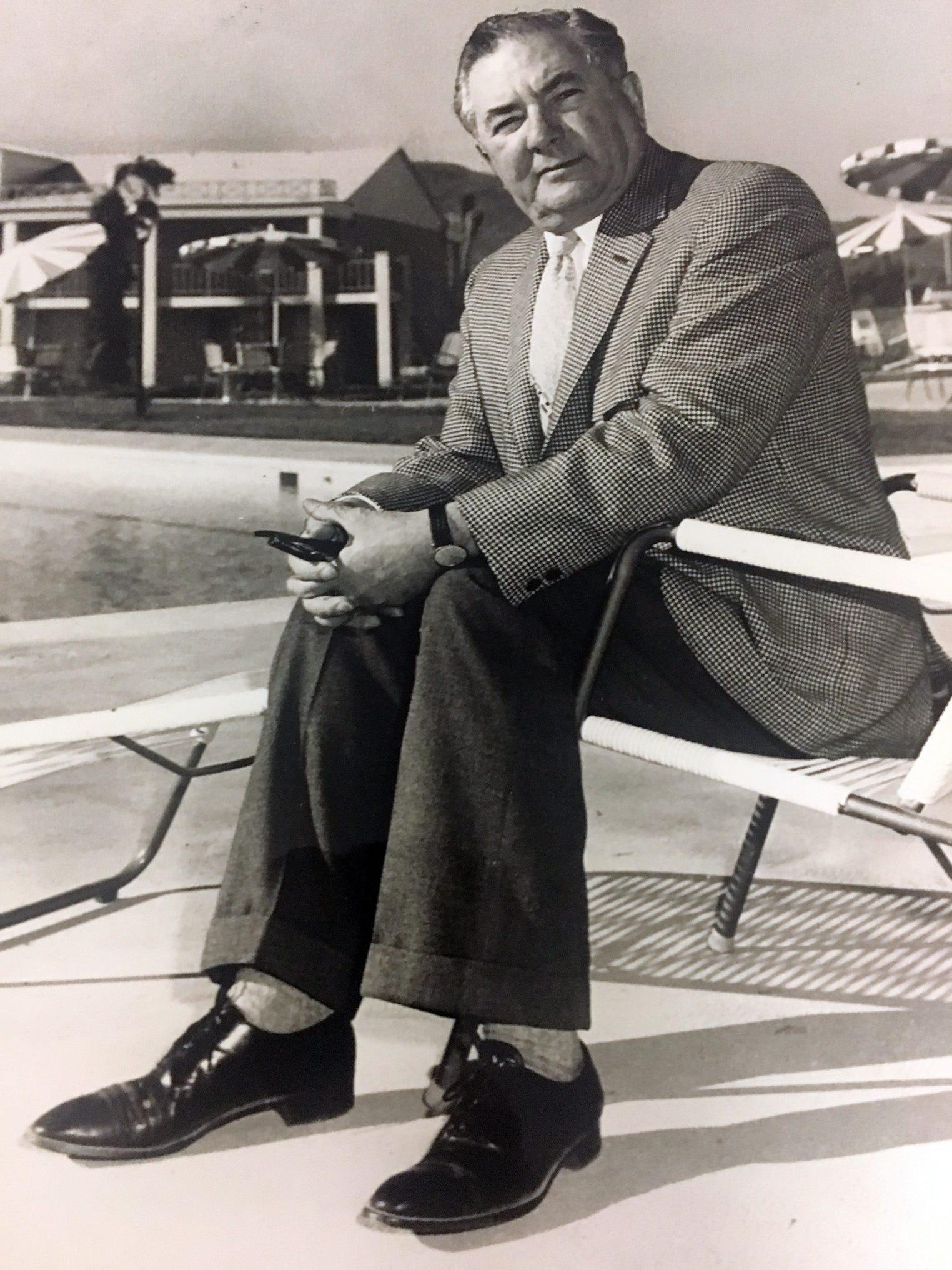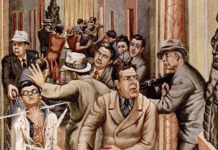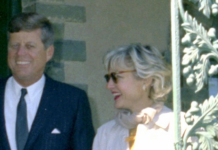
The man who tipped off New Orleans D.A. Jim Garrison about the corruption of the Warren Commission was poised to be the next Speaker of the House before his plane went down in October 1972 and could have potentially been president.
[This article follows CAM’s series on political assassinations—Editors]
On October 16, 1972, a Cessna 310 with the tail number N1812H operated by Pan Alaska Airways disappeared somewhere between Anchorage and Juneau, Alaska.
The passengers on the plane were Alaska Democratic Congressman Nick Begich, 40, his aide Russell Brown, 37, and Louisiana Democratic Congressman Hale Boggs, 58, the House Majority Leader who was poised to be the next House speaker.

The three men were planning to attend an election rally for Begich—who had helped pass a major Native land claim transfer as a freshman congressman—in Juneau.[1]
Boggs was taken to the airport for the first leg of the trip, ironically, by Bill Clinton, then the Texas coordinator for George McGovern’s presidential campaign. Clinton is known to have worked for the CIA since his days as a student at Oxford.
The weather the day of the crash was fine for flying, though Juneau had fog and icy rains, and some turbulent head winds were forecast en route. The pilot, Don Jonz, 38, was chief pilot for Pan Alaska and a military veteran with more than 17,000 hours of flight time.
When the plane did not arrive in Juneau and was declared missing, the U.S. launched the largest search-and-rescue effort on record as of then.
The search lasted 39 days and included 40 military aircraft and 50 civilian planes covering more than 325,000 square miles. Pilots flew 1,000 sorties totaling 3,600 flight hours. The search encompassed huge glaciers and the jagged Wrangell St. Elias Mountain Range, as well as large portions of the coastlines of Prince William Sound and the Gulf of Alaska.
In addition to the air operation, ground patrols searched Portage Pass twice.

No piece of the aircraft was ever located during the initial search or since, and officials at the time decided the plane likely crashed and either sank into Prince William Sound or was buried in ice and snow.
Officials terminated the search for the airplane on November 24th, and the four men were declared dead on December 29th. The families were told that key military documents from the search had been destroyed though, remarkably, some later turned up.
In another curious twist, right after the plane was reported missing, the U.S. Coast Guard station in Long Beach, California, received a call from an anonymous tipster claiming he knew where the plane had crashed. The man said he had access to experimental electronic equipment, and he provided detailed directions to the coordinates of the downed airplane.

According to recently released documents, the FBI apparently found the source believable, and one agent wrote, “The source of the aforementioned information is reliable.” Agents who interviewed the man reported he “appeared rational, extremely intelligent, but somewhat strange.” It is not clear whether searchers checked the coordinates the tipster provided.
In the hours and days following the disappearance of the plane, several independent ham radio operators in Northern California reported hearing a transmission allegedly from someone on the downed plane broadcasting there were two survivors on the plane. Searchers were never able to pinpoint the location of the origin of these transmissions.
According to the FBI file, the day after the plane disappeared, a search plane picked up a signal for 40 minutes some distance from Juneau from what was believed to be a crash locator beacon. Another, weaker, signal was heard 150 miles northeast of Anchorage, but search planes were unable to pinpoint the source of either signal.

Curiously, on November 24, when an emergency beacon and light from a possible crash site in a remote area was located, President Richard M. Nixon cancelled the search and ordered all Coast Guard and U.S. military personnel home—right at the time that it looked like the ruints from the plane might have been found.
Dissenting Member of the Warren Commission
Suspicions of foul play in the crash were enhanced by the important political implications of Hale Boggs’s death.
First elected to Congress in 1941 at the age of 26, Boggs became known for sponsoring a 1952 bill that set mandatory sentences for drug-related offenses, though compiled a substantially more liberal voting record than most other southern Democrats, helping to usher in much of LBJ’s Great Society program as Majority Whip.[2]

Boggs and his wife Lindy had been very close to Sam Rayburn, one of LBJ’s top political supporters and friends and Lindy was one of Lady Bird Johnson’s closest friends in Washington, D.C. Boggs was appointed to the Warren Commission because LBJ thought he could manipulate him through their friendship.
LBJ set up the Warren Commission, as credible evidence indicates, and as many researchers now believe (including this writer), in order to cover up his role in orchestrating the JFK assassination with elements of the CIA. Its release was perfectly timed for before the 1964 election in which Johnson defeated Barry Goldwater.
The sham nature of the Warren Commission was evident in its spending days questioning unimportant witnesses over unimportant details, and its amassing thousands of pages of irrelevant documents to give it a fake professional veneer. Determining that Lee Harvey Oswald was a “killer without motive,” it did not even look at the autopsy, x-rays and photographs of JFK’s body, choosing instead to put this and other important evidence into a box under seal which it ordered not to be released until 2039.
A Warren Commission staff member, David Belin, appears to have altered the testimony of one witness, Victoria Adams, who worked in the Texas School Book Depository, to make it more plausible that Oswald could have been the shooter.
Boggs signed off on the Warren Commission report like all others but became the most vocal critic of its findings that Oswald was the lone assassin. Author Joan Mellen interviewed Phyllis Garrison, the second wife of Jim Garrison, who told Mellen it was Hale Boggs who in the fall of 1966 was telling Jim Garrison how corrupted the Warren Report was.[3]

From his experiences as a hunter, Boggs believed that one man could not have fired the shots that killed Kennedy. Boggs told Garrison that no notes, no transcription had been made of the hours of interrogation of Oswald by the Dallas police, which also claimed to have no record of the calls received and made by Oswald while he was in custody. This was indicative of a police coverup.
John H. Davis asserts in his 1989 book, Mafia Kingfish: Carlos Marcello and the Assassination of John F. Kennedy, that Boggs came to believe that the CIA was involved in the Kennedy assassination, based on his conviction that the CIA had withheld critical information from the Warren Commission.[4]
Besides his skepticism of the Warren report, Boggs was one of the first to investigate the Watergate scandal and according to The Los Angeles Star, had startling revelations on that as well. Richard Nixon made some unintelligible remarks about Congressman Boggs which were recorded on the White House tapes, just seven days after the Watergate break-in.
Believing that J. Edgar Hoover was totally corrupt, Boggs began to openly feud with the FBI before his death, warning that the U.S. was becoming increasingly totalitarian.[5]
In a conversation with an aide, Boggs said that “[FBI Director J. Edgar] Hoover lied his eyes out to the [Warren] Commission on Oswald, on Ruby, on their friends, the bullets, the gun…”[6]

Boggs was further appalled by the fact that the authors of seven books critical of the Warren Report were investigated by the FBI and their military discharges and associations with “leftist organizations” were paraded before Commission members, LBJ, and FBI-favored press contacts.
Boggs said that, “over the post-war years, we have granted to the elite and secret police within our system vast new powers over the lives and liberties of the people.”
On April 5, 1971, Boggs demanded Hoover’s resignation on the House floor, accusing Hoover and the FBI of tapping the telephones of members of Congress and stationing agents on campuses to spy on students and faculty members. He said these were ‘’the tactics of the Soviet Union and Hitler’s Gestapo.”

“A Real Conspiracy That Played Out”
In the 1979 novel The Matarese Circle, author Robert Ludlum portrayed Boggs as having been killed to stop an independent investigation he was carrying out of the Kennedy assassination.
Dr. Nick Begich, whose father died with Boggs in the crash, told an interviewer in 2011 that their plane “disappeared at a critical time in history,” as Boggs had been “poised to be the next speaker of the House and wanted to reopen the Warren Commission and restore personal freedom and liberty and reign in the FBI.”


Boggs’s death, however, ensured that the Warren Commission was not revived and that Hoover’s modus operandi in effect continued even after his death, and that the U.S. government became more and more autocratic, leading to the state of disrepair that we are in today.
Boggs’s replacement as House Speaker, Oklahoma Democrat Carl Albert, was an alcoholic who would never challenge the powers that be—neither would his successor Tip O’Neill.

Begich said that, after Nixon resigned and Spiro Agnew was bounced as Vice President and Gerald Ford came in, Lynette “Squeaky” Fromme—one of the Manson girls—tried to kill Ford so Nelson Rockefeller could become president.

Boggs, as the House Speaker, would have been increasingly powerful at this time had he lived and a potential future president—they might have even gotten Nixon and Agnew out at the same time during Watergate and as third in line, Boggs would then have become the commander-in-chief.
“Isn’t this all interesting,” Begich said. “Talk about conspiracy theory—actually it is a real conspiracy that played out.”
Previous Intimidation
Late at night on July 23, 1970—two years before he disappeared—a Lincoln Continental ran Boggs’s car off the road in Washington, D.C.
Boggs chased the car, wrote down the license plate number, and called the police, but there is no record that the incident was investigated.
Washington, D.C.’s Metropolitan Police Department would have been the agency in charge of the investigation, but said they could find no relevant records relating to the case.
In April 1971, Boggs claimed the FBI tapped his telephone. Attorney General John Mitchell denied Boggs’s allegations, but Boggs said he was “absolutely certain.”
Mafia Bomber

The intelligence agencies or “deep state” often use the Mafia to carry out their criminal operations.
On March 4, 1974, less than 17 months after the disappearance of her husband, Pegge Begich, the widow of Congressman Nick Begich, married Jerry Max Pasley, who worked for mobsters Peter Licavoli, Sr., and Joe Bonanno, Sr. The marriage lasted three years.
In 1994 while incarcerated, Pasley said that, in 1972, he had delivered a bomb from Arizona to Anchorage at the behest of the Joe Bonanno crime syndicate, which was connected to the CIA through its operations in Cuba and Haiti, where it had allied with Francois “Papa Doc” DuValier.
Pasley spoke with investigators from the Anchorage Police Department, Alaska State Troopers and Arizona Department of Public Safety, three of whom confirmed this in an interview on a “Prison Vent” podcast.

Pasley said that, in 1972, he was handed a locked briefcase by a Licavoli lieutenant in Arizona. He was instructed to take the briefcase to Anchorage where he handed it to two men. He flew back to Arizona the following day. He said he was told “something big” was about to happen.


Soon afterward, the plane carrying Begich and Boggs disappeared.
William Scott Day (deceased 2006) wrote prison letters recounting verbal exchanges that he had in prison with Pasley that addressed the topic of the alleged Alaska assassinations.
Day confirmed that Boggs was the target for Hoover and some of his acolytes even though Hoover died shortly before the Boggs hit. Licavoli ordered the hit, according to Day. Pasley in this account admitted to assembling the bomb and placing it on the plane.

-
Begich, at the time, was facing a tight race with his Republican adversary, Don Young, who would go on to win the seat after his death and remain in office until his death in 2022. ↑
A graduate of Tulane law school, Boggs became a leader in the movement to break the power of the political machine of Senator Huey Pierce Long Jr., who was assassinated in 1935. In 1956 Boggs signed the Southern Manifesto condemning desegregation though later supported the 1964 Civil Rights and 1965 Voting Rights Acts. Described by Sam Rayburn as a “moderate conservative” and calling himself a “middle of the roadist,” Boggs supported the House of Un-American Activities Committee (HUAC), though also derided the excesses of anticommunist witch-hunters who targeted him at one point in the state of Louisiana. See Garry Boulard, The Big Lie: Hale Boggs, Lucille May Grace, and Leander Perez in 1951 (Gretna, Louisiana: Pelican Publishing Company, 2001), 50, 97. Boggs supported Johnson and Nixon’s Vietnam policy, and liberal foreign trade policies. Boldly opposing the oil depletion allowance, in the 1950s he passed tax legislation designed to fund the interstate highway system. ↑
-
Joan Mellen, A Farewell to Justice: Jim Garrison, JFK’s Assassination, and the Case That Should Have Changed History (Washington, D.C.: Potomac Books, 2007). Politico reported that “Boggs dissented from the [Warren] commission’s majority report which supported the single bullet thesis—pointing to a lone assassin. Boggs said he ‘had strong doubts about it.’” ↑
-
John H. Davis, Mafia Kingfish: Carlos Marcello and the Assassination of John F. Kennedy (New York: Signet Books, 1989). ↑
-
In April 1971, Boggs made a speech on the floor of the House in which he strongly attacked Hoover and the whole of the FBI. ↑
-
Jesse Ventura, with Dick Russell, American Conspiracies (New York: Skyhorse Publishing, 2010), 33. ↑
CovertAction Magazine is made possible by subscriptions, orders and donations from readers like you.
Blow the Whistle on U.S. Imperialism
Click the whistle and donate
When you donate to CovertAction Magazine, you are supporting investigative journalism. Your contributions go directly to supporting the development, production, editing, and dissemination of the Magazine.
CovertAction Magazine does not receive corporate or government sponsorship. Yet, we hold a steadfast commitment to providing compensation for writers, editorial and technical support. Your support helps facilitate this compensation as well as increase the caliber of this work.
Please make a donation by clicking on the donate logo above and enter the amount and your credit or debit card information.
CovertAction Institute, Inc. (CAI) is a 501(c)(3) non-profit organization and your gift is tax-deductible for federal income purposes. CAI’s tax-exempt ID number is 87-2461683.
We sincerely thank you for your support.
Disclaimer: The contents of this article are the sole responsibility of the author(s). CovertAction Institute, Inc. (CAI), including its Board of Directors (BD), Editorial Board (EB), Advisory Board (AB), staff, volunteers and its projects (including CovertAction Magazine) are not responsible for any inaccurate or incorrect statement in this article. This article also does not necessarily represent the views the BD, the EB, the AB, staff, volunteers, or any members of its projects.
Differing viewpoints: CAM publishes articles with differing viewpoints in an effort to nurture vibrant debate and thoughtful critical analysis. Feel free to comment on the articles in the comment section and/or send your letters to the Editors, which we will publish in the Letters column.
Copyrighted Material: This web site may contain copyrighted material the use of which has not always been specifically authorized by the copyright owner. As a not-for-profit charitable organization incorporated in the State of New York, we are making such material available in an effort to advance the understanding of humanity’s problems and hopefully to help find solutions for those problems. We believe this constitutes a ‘fair use’ of any such copyrighted material as provided for in section 107 of the US Copyright Law. You can read more about ‘fair use’ and US Copyright Law at the Legal Information Institute of Cornell Law School.
Republishing: CovertAction Magazine (CAM) grants permission to cross-post CAM articles on not-for-profit community internet sites as long as the source is acknowledged together with a hyperlink to the original CovertAction Magazine article. Also, kindly let us know at info@CovertActionMagazine.com. For publication of CAM articles in print or other forms including commercial internet sites, contact: info@CovertActionMagazine.com.
By using this site, you agree to these terms above.
About the Author

Jeremy Kuzmarov holds a Ph.D. in American history from Brandeis University and has taught at numerous colleges across the United States. He is regularly sought out as an expert on U.S. history and politics for radio and TV programs and co-hosts a radio show on New York Public Radio and on Progressive Radio News Network called “Uncontrolled Opposition.”
He is Managing Editor of CovertAction Magazine and is the author of six books on U.S. foreign policy, including Obama’s Unending Wars (Clarity Press, 2019), The Russians Are Coming, Again, with John Marciano (Monthly Review Press, 2018), Warmonger. How Clinton’s Malign Foreign Policy Launched the U.S. Trajectory From Bush II to Biden (Clarity Press, 2023); and with Dan Kovalik, Syria: Anatomy of Regime Change (Baraka Books, 2025).
Besides these books, Kuzmarov has published hundreds of articles and contributed to numerous edited volumes, including one in the prestigious Oxford History of Counterinsurgency .
He can be reached at jkuzmarov2@gmail.com and found on substack here.










